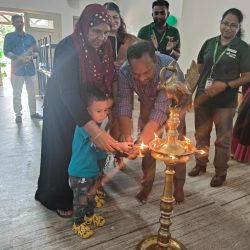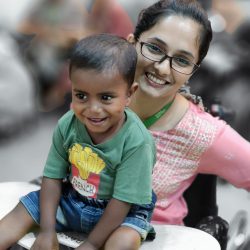August 2010
SPOTLIGHT…
 It is wonderful to get bouquets; but brickbats help us to improve.
It is wonderful to get bouquets; but brickbats help us to improve.
We got such an opportunity recently during a support group meeting for the bereaved. While speaking of his experiences, a gentleman who had lost his wife a month ago said he was very thankful to us for having looked after his wife so well. Doesn’t it feel wonderful to be appreciated? It sure does!
“But,” he said, “no one ever asked me how I felt or how I coped. I was going through Hell. I did not feel it was right to ask for help when you were all so concerned about my wife.”
What an eye-opener! We had been feeling complacent that we had taken due care to include the family under the umbrella of our service, and here was this man telling us we had missed something, failed somewhere; there had been a lack, a deficiency.
He reminded us to always ask, particularly when the person appears to be strong and apparently coping well. Those obviously weak always get attention…isn’t there a saying, a crying child gets its milk? It is the one who seems to cope that might be suffering the most…so, let us look beyond the face to what could be happening behind the façade… we learnt that we need to be more alert, more vigilant.
–
Pallium India-USA at Sevathon 2010
 Pallium India-USA had it’s very first event at the Sevathon at the Sunnyvale Baylands Park in California, thanks to the initiative of its founder-president, Dr Jerina Kapoor.
Pallium India-USA had it’s very first event at the Sevathon at the Sunnyvale Baylands Park in California, thanks to the initiative of its founder-president, Dr Jerina Kapoor.
It was attended by an estimated 2,500 people, and the atmosphere was full of enthusiasm and good cheer. It was a great opportunity for us to introduce ourselves to the local community as well as the other Indian charities.
People were very curious about palliative care issues and the work being done by Pallium India. Our colorful booth was manned by Uday, Abhilash and Jerina, and people found our collage informative. Many promised to attend our upcoming event on Sept. 26th.
Thank you Neethu Raj, Arnavaz Wadia, Rashna Wadia and Pushpa Menon for helping us put this together. A very special mention and thanks to Smita Patel and Abhilash Rajagopal without whose selfless work this event would not have been possible.
–
Indian Journal of Palliative Care Now in PubMed
 Great news! The Indian Journal of Palliative Care has been indexed by PubMed!
Great news! The Indian Journal of Palliative Care has been indexed by PubMed!
Hearty congratulations to the editor Dr Sushma Bhatnagar for her hard work and commitment in making this happen. We are all proud of your achievement, Sushma!
The IJPC is now available through: AMED, Caspur, DOAJ, EBSCO Publishing’s Electronic Databases, EMCARE, Expanded Academic ASAP, Genamics JournalSeek, Google Scholar, Health & Wellness Research Center, Health Reference Center Academic, Hinari, Index Copernicus, OpenJGate, ProQuest, PubMed, Pubmed Central, Scimago Journal Ranking, SCOLOAR, SCOPUS, SIIC databases, SNEMB, and Ulrich’s International Periodical Directory.
But perhaps our greatest achievement has been that the journal is available online free! Just visit: www.jpalliativecare.com
And at this happy moment, let us also gratefully remember the founders of IAPC and of the journal along with its former editors, Dr Mrs. Shah, Dr Prabha Chandra, Dr Reena George and Dr Jacob Alexander who built up the standard of the journal step by step and helped in realization of this dream.
–
Sahayatra: Pallium India’s Malayalam Newsletter
 We are happy to announce that SAHAYATRA, our monthly Malayalam newsletter, is now available for download from our website.
We are happy to announce that SAHAYATRA, our monthly Malayalam newsletter, is now available for download from our website.
SAHAYATRA is meant for anyone interested in palliative care – patients and families, palliative care professionals, volunteers and well-wishers.
Download PDF: Sahayatra July 2010
Future editions will be available here: palliumindia.live-website.com/sahayatra
–
Project Hamrahi Takes Off!
Some time ago, we had reported to you about Project Hamrahi, a mentoring program in which an Australian mentor is to be matched to a budding palliative care center in India with a view to long term relationships and continued support.

Very appropriately, the first ever mentor under the program to visit India has been our long-term friend, Dr Odette Spruyt, Head of Pain and Palliative Care Department, Peter MacCallum Cancer Centre, Melbourne, Australia.
As we write this, Dr Spruyt is in Patna, at the prestigious Indira Gandhi Institute of Medical Sciences (IGIMS), where a joint Pallium India-IGIMS palliative care project took off in 2009.
While addressing a lecture at a Continuing Medical Education (CME) programme on “Pain and Palliative Care”, jointly organised by the Dept. of Anaesthesiology and Regional Cancer Centre (RCC), IGIMS, on 31-07-2010, she stressed how imperative it was to provide emotional support to the terminally ill patients of cancer and other fatal diseases, and their family members, in addition to pain management, so that the quality of life of the last days of such patients could improve.
Dr Spruyt has been working with the palliative care team at IGIMS from July 26 for a week. Addressing doctors, nurses, para-medical, staffs and representatives of NGOs, she emphasized the importance of management of cancer patients which also includes all aspects of communication with the patients and the significant role of family members, society and NGOs in alleviating the patient’s suffering. She also threw light on how to deal with the family members after the death of their relatives.
Dr Arun Kumar,Director, IGIMS; Dr R R Prasad, Head, RCC ;Dr Sukumar Jha, HoD, General Surgery, IGIMS,and anaesthesiologists Dr Ajit Gupta and Dr K H Raghvendra also addressed the CME.
–
Great News from Guwahati, Assam
 The Regional Cancer Center (RCC) at Dr B Borooah Cancer Institute has created a full time position in Palliative Care.
The Regional Cancer Center (RCC) at Dr B Borooah Cancer Institute has created a full time position in Palliative Care.
Dr Kabindra Bhagawati has been appointed as a palliative care physician in that position.
The relevance of this cannot be underestimated.


In Assam, as in the rest of the country, Palliative Care started as a charitable activity. Dr Dinesh Chandra Goswami founded the Guwahati Pain and Palliative Care Society (GPPCS) in May 1999. Since then, GPPCS has been providing palliative care to the patients in the RCC.
One major weakness of the whole palliative care movement in the country has been that integration with mainstream medicine has been poor. But this development in Guwahati is encouraging.
Kabindra underwent a Basic Certificate Course in Palliative Care from Calicut in 1999 and a Diploma in Palliative Medicine from Edith Cowan University in Perth, Australia.
Congratulations, Kabindra and Dinesh! And thank you from all of us for your hard work and commitment that made all this possible.
–
FROM THE MEDIA…
Patient Navigation and Doordarshan TV
 Thank you, Doordarshan!
Thank you, Doordarshan!
The national television channel Doordarshan (Malayalam) has been exceptionally supportive of palliative care. In their live phone-in program, Snehasparsham, palliative care has had a strong presence for the last several months.

One recent phone-in program was conducted by Dr M.C. Rajasree from Pain and Palliative Care Society, Calicut. The nature of questions clearly indicated how commonly patients and families were at a loss about whom to approach for help.
This is particularly relevant in India, where the “general practitioner” is practically non-existent and in practice, patients are left to find out for themselves which specialist to approach.
Dr Rajasree directed each questioner to the nearest palliative care unit for advice. This clearly demonstrates a hidden service that palliative care services are doing. They explain. They talk to patients and help to direct them to the appropriate medical service that would be suitable for them.
But the need for this service is not taken seriously, perhaps. Palliative care services in Kerala have by and large catered to general health needs of people.
Perhaps we need to give more attention to patient navigation?
–
Lancet on Palliative Care in Developing Countries
Picking up on the white paper from the Economist Intelligence Unit, the Lancet points out that 40% of the World’s population dwell at the bottom of the end-of-life care rankings:
Painfully slow progress on palliative care
To meet death without a surfeit of pain and discomfort is a fundamental right. Yet, according to The Quality of Death, a report published by the Economist Intelligence Unit, it is a right denied to all but 8% of patients who need palliative care worldwide every year. The authors used a range of indicators to rank 40 countries by the quality and availability of their end-of-life care. The UK holds the top spot overall, bearing testament to the strides made since the foundation of St Christopher’s Hospice—the first dedicated palliative care hospice in the world—in 1967. Globally, however, the picture is one of low standards and slow progress.
Brazil, Russia, India, and China—which account for 40% of the world’s population—occupy four of the bottom six places in the list, along with Mexico and Uganda. But even patients in developed nations such as South Korea (32nd), Japan (23rd), and Denmark (22nd) are being denied access to good end-of-life care through a combination of inadequate policy, poor training, poor access to painkillers, and cultural barriers.
In a world where death and taxes are the only certainties, taxes are considered the more palatable topic for discussion. Death and dying remain taboo subjects in many cultures, which presents a major barrier to improving end-of-life care. Deeply embedded attitudes will not change overnight, but campaigns such as Dying Matters, which launched in the UK earlier this year, show that it is possible to engage with the public and foster an acceptance of death as a natural process.
A more pressing practical concern is that about 5 billion people worldwide lack access to opioid pain relief, mainly because of fears the drugs will reach the black market. Even where opioids are available, inadequate training often means doctors are unable to safely administer them. What is clear is that none of the impediments to improving end-of-life care will be overcome without strong leadership and detailed support from policy makers. With people older than 65 years soon to outnumber children younger than 5 years for the first time in recorded history, time is very much of the essence.
Food for thought, is it not?
Visit the campaign site: DyingMatters.org
–
Death with Dignity
![]() An article written by Mr T.V. Jayan in Calcutta’s daily newspaper, The Telegraph, refers to the same white paper and deals with the India’s need for palliative care. It describes the development of the palliative care movement in Kerala and talks about the deplorable state of affairs in most of the country:
An article written by Mr T.V. Jayan in Calcutta’s daily newspaper, The Telegraph, refers to the same white paper and deals with the India’s need for palliative care. It describes the development of the palliative care movement in Kerala and talks about the deplorable state of affairs in most of the country:
PK. Ashokkumar remembers those days so well. He watched his friend’s wife slowly succumb to the rogue cells that were eating up her body. The two doctors tending 28-year-old Soumini Radhakrishnan knew they couldn’t keep her alive, but were determined that she would die with dignity. Kumar watched while they steered her towards a near painless death — giving birth to a movement that has now swept across Kerala.
Read more at The Telegraph…
–
BMJ: The Politics Of Pain
 Pain relief is often taken for granted in the Western world, but in about 150 countries the use of morphine is severely restricted, says Tatum Anderson in British Medical Journal, “The politics of pain“.
Pain relief is often taken for granted in the Western world, but in about 150 countries the use of morphine is severely restricted, says Tatum Anderson in British Medical Journal, “The politics of pain“.
She investigates how this has come about, and what steps are being taken to stop patients living and dying in extreme pain.
Here is part of what she says about India in the article:
India may be one of the world’s largest legitimate opium growers, but only about 0.4% of the population in need of opioids for pain relief get them, according to figures from 2007.
Restrictions result from an attempt to tackle the growing drugs trade. In 1985 the government passed a law that required pharmacies to have multiple licences from different agencies before they could stock and dispense morphine. The drug then disappeared from the shelves and doctors stopped prescribing it.
Realising the inadvertent consequences of its law, the government then allowed India’s states to amend rules to allow hospices to stock and dispense morphine without complex licensing. The problem is, only a few states have chosen to do so. And the new rules do not affect the onerous pharmacy licensing system, which still applies.
Full text is available if you have access to BMJ here…
–
Is India the Worst Place to Die?
 India has the 4th largest GDP in the world, but, in terms of providing palliative care, it ranks even lower than Uganda – an economy 90 times smaller than that of India.
India has the 4th largest GDP in the world, but, in terms of providing palliative care, it ranks even lower than Uganda – an economy 90 times smaller than that of India.
In a few years, those aged above 65 years would soon outnumber children under the age of 5; by 2030, their population would touch a billion… a burgeoning section of society whose demands on health care, and specially palliative care, threaten to topple the existing frail systems.
Is it a surprise that in a nation where three-fourths of the population survive a daily existence, unaware how to “live” a life, there isn’t much thought given to how we die? [..] dignity in death is a pipe dream for those who have to fight for dignity in life…
So writes Ameet Bhuvan from Bhubaneswar, India, in response to a Healthcare Report “How We Are Dying?”, featured in the Outlook magazine, which has picked up on the report from the Economist’s Report and Index on Quality of Death and Dying.
But, Kerala stands as a “beacon of hope”. With only 3% of the country’s population, Kerala is not only the lone state to have a formal palliative care policy in place; it also provides 2/3 of the care services available in India, with the government providing funding for community based care programmes.
It is also one of the first of Indian states to relax narcotics regulation to permit use of morphine by palliative care providers.
More interesting insights into this issue are available at Outlook Magazine: How We Are Dying?.
–
HAPPY ONAM…
Onam is the annual harvest festival of Kerala, one that symbolises plenty, truth and honesty.





